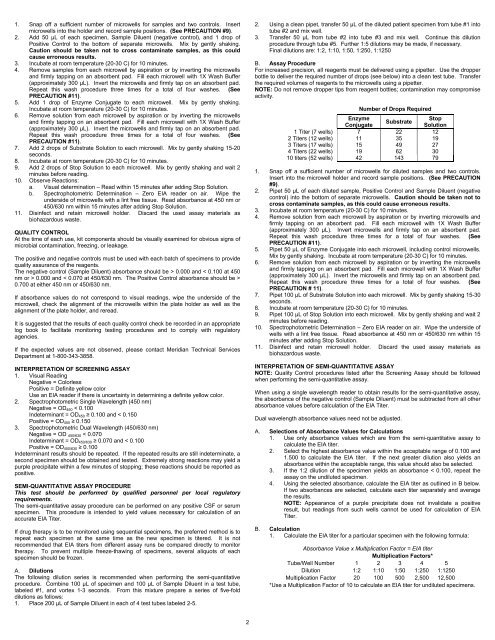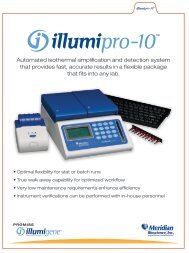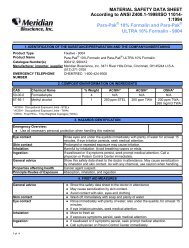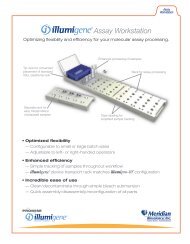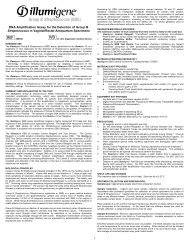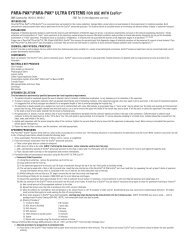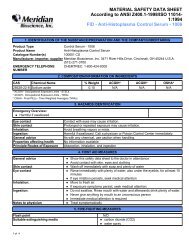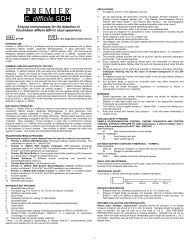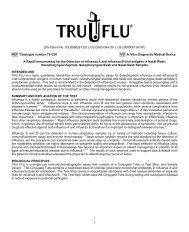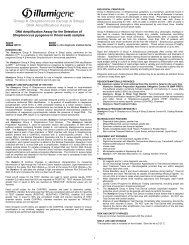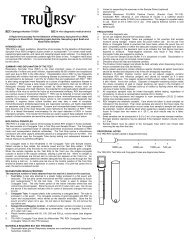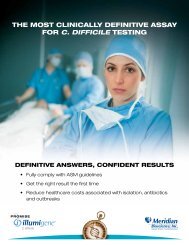Premier™ Cryptococcal Antigen - Meridian Bioscience, Inc.
Premier™ Cryptococcal Antigen - Meridian Bioscience, Inc.
Premier™ Cryptococcal Antigen - Meridian Bioscience, Inc.
You also want an ePaper? Increase the reach of your titles
YUMPU automatically turns print PDFs into web optimized ePapers that Google loves.
1. Snap off a sufficient number of microwells for samples and two controls. Insert<br />
microwells into the holder and record sample positions. (See PRECAUTION #9).<br />
2. Add 50 µL of each specimen, Sample Diluent (negative control), and 1 drop of<br />
Positive Control to the bottom of separate microwells. Mix by gently shaking.<br />
Caution should be taken not to cross contaminate samples, as this could<br />
cause erroneous results.<br />
3. <strong>Inc</strong>ubate at room temperature (20-30 C) for 10 minutes.<br />
4. Remove samples from each microwell by aspiration or by inverting the microwells<br />
and firmly tapping on an absorbent pad. Fill each microwell with 1X Wash Buffer<br />
(approximately 300 µL). Invert the microwells and firmly tap on an absorbent pad.<br />
Repeat this wash procedure three times for a total of four washes. (See<br />
PRECAUTION #11).<br />
5. Add 1 drop of Enzyme Conjugate to each microwell. Mix by gently shaking.<br />
<strong>Inc</strong>ubate at room temperature (20-30 C) for 10 minutes.<br />
6. Remove solution from each microwell by aspiration or by inverting the microwells<br />
and firmly tapping on an absorbent pad. Fill each microwell with 1X Wash Buffer<br />
(approximately 300 µL). Invert the microwells and firmly tap on an absorbent pad.<br />
Repeat this wash procedure three times for a total of four washes. (See<br />
PRECAUTION #11).<br />
7. Add 2 drops of Substrate Solution to each microwell. Mix by gently shaking 15-20<br />
seconds.<br />
8. <strong>Inc</strong>ubate at room temperature (20-30 C) for 10 minutes.<br />
9. Add 2 drops of Stop Solution to each microwell. Mix by gently shaking and wait 2<br />
minutes before reading.<br />
10. Observe Reactions:<br />
a. Visual determination – Read within 15 minutes after adding Stop Solution.<br />
b. Spectrophotometric Determination – Zero EIA reader on air. Wipe the<br />
underside of microwells with a lint free tissue. Read absorbance at 450 nm or<br />
450/630 nm within 15 minutes after adding Stop Solution.<br />
11. Disinfect and retain microwell holder. Discard the used assay materials as<br />
biohazardous waste.<br />
QUALITY CONTROL<br />
At the time of each use, kit components should be visually examined for obvious signs of<br />
microbial contamination, freezing, or leakage.<br />
The positive and negative controls must be used with each batch of specimens to provide<br />
quality assurance of the reagents.<br />
The negative control (Sample Diluent) absorbance should be > 0.000 and < 0.100 at 450<br />
nm or > 0.000 and < 0.070 at 450/630 nm. The Positive Control absorbance should be ><br />
0.700 at either 450 nm or 450/630 nm.<br />
If absorbance values do not correspond to visual readings, wipe the underside of the<br />
microwell, check the alignment of the microwells within the plate holder as well as the<br />
alignment of the plate holder, and reread.<br />
It is suggested that the results of each quality control check be recorded in an appropriate<br />
log book to facilitate monitoring testing procedures and to comply with regulatory<br />
agencies.<br />
If the expected values are not observed, please contact <strong>Meridian</strong> Technical Services<br />
Department at 1-800-343-3858.<br />
INTERPRETATION OF SCREENING ASSAY<br />
1. Visual Reading<br />
Negative = Colorless<br />
Positive = Definite yellow color<br />
Use an EIA reader if there is uncertainty in determining a definite yellow color.<br />
2. Spectrophotometric Single Wavelength (450 nm)<br />
Negative = OD450 < 0.100<br />
Indeterminant = OD450 ≥ 0.100 and < 0.150<br />
Positive = OD450 ≥ 0.150<br />
3. Spectrophotometric Dual Wavelength (450/630 nm)<br />
Negative = OD 450/630 < 0.070<br />
Indeterminant = OD450/630 ≥ 0.070 and < 0.100<br />
Positive = OD450/630 ≥ 0.100<br />
Indeterminant results should be repeated. If the repeated results are still indeterminate, a<br />
second specimen should be obtained and tested. Extremely strong reactions may yield a<br />
purple precipitate within a few minutes of stopping; these reactions should be reported as<br />
positive.<br />
SEMI-QUANTITATIVE ASSAY PROCEDURE<br />
This test should be performed by qualified personnel per local regulatory<br />
requirements.<br />
The semi-quantitative assay procedure can be performed on any positive CSF or serum<br />
specimen. This procedure is intended to yield values necessary for calculation of an<br />
accurate EIA Titer.<br />
If drug therapy is to be monitored using sequential specimens, the preferred method is to<br />
repeat each specimen at the same time as the new specimen is titered. It is not<br />
recommended that EIA titers from different assay runs be compared directly to monitor<br />
therapy. To prevent multiple freeze-thawing of specimens, several aliquots of each<br />
specimen should be frozen.<br />
A. Dilutions<br />
The following dilution series is recommended when performing the semi-quantitative<br />
procedure. Combine 100 µL of specimen and 100 µL of Sample Diluent in a test tube,<br />
labeled #1, and vortex 1-3 seconds. From this mixture prepare a series of five-fold<br />
dilutions as follows:<br />
1. Place 200 µL of Sample Diluent in each of 4 test tubes labeled 2-5.<br />
2<br />
2. Using a clean pipet, transfer 50 µL of the diluted patient specimen from tube #1 into<br />
tube #2 and mix well.<br />
3. Transfer 50 µL from tube #2 into tube #3 and mix well. Continue this dilution<br />
procedure through tube #5. Further 1:5 dilutions may be made, if necessary.<br />
Final dilutions are: 1:2, 1:10, 1:50, 1:250, 1:1250<br />
B. Assay Procedure<br />
For increased precision, all reagents must be delivered using a pipetter. Use the dropper<br />
bottle to deliver the required number of drops (see below) into a clean test tube. Transfer<br />
the required volumes of reagents to the microwells using a pipetter.<br />
NOTE: Do not remove dropper tips from reagent bottles; contamination may compromise<br />
activity.<br />
Number of Drops Required<br />
Enzyme<br />
Conjugate<br />
Substrate<br />
Stop<br />
Solution<br />
1 Titer (7 wells) 7 22 12<br />
2 Titers (12 wells) 11 35 19<br />
3 Titers (17 wells) 15 49 27<br />
4 Titers (22 wells) 19 62 30<br />
10 titers (52 wells) 42 143 79<br />
1. Snap off a sufficient number of microwells for diluted samples and two controls.<br />
Insert into the microwell holder and record sample positions. (See PRECAUTION<br />
#9).<br />
2. Pipet 50 µL of each diluted sample, Positive Control and Sample Diluent (negative<br />
control) into the bottom of separate microwells. Caution should be taken not to<br />
cross contaminate samples, as this could cause erroneous results.<br />
3. <strong>Inc</strong>ubate at room temperature (20-30 C) for 10 minutes.<br />
4. Remove solution from each microwell by aspiration or by inverting microwells and<br />
firmly tapping on an absorbent pad. Fill each microwell with 1X Wash Buffer<br />
(approximately 300 µL). Invert microwells and firmly tap on an absorbent pad.<br />
Repeat this wash procedure three times for a total of four washes. (See<br />
PRECAUTION #11).<br />
5. Pipet 50 µL of Enzyme Conjugate into each microwell, including control microwells.<br />
Mix by gently shaking. <strong>Inc</strong>ubate at room temperature (20-30 C) for 10 minutes.<br />
6. Remove solution from each microwell by aspiration or by inverting the microwells<br />
and firmly tapping on an absorbent pad. Fill each microwell with 1X Wash Buffer<br />
(approximately 300 µL). Invert the microwells and firmly tap on an absorbent pad.<br />
Repeat this wash procedure three times for a total of four washes. (See<br />
PRECAUTION # 11).<br />
7. Pipet 100 µL of Substrate Solution into each microwell. Mix by gently shaking 15-30<br />
seconds.<br />
8. <strong>Inc</strong>ubate at room temperature (20-30 C) for 10 minutes.<br />
9. Pipet 100 µL of Stop Solution into each microwell. Mix by gently shaking and wait 2<br />
minutes before reading.<br />
10. Spectrophotometric Determination – Zero EIA reader on air. Wipe the underside of<br />
wells with a lint free tissue. Read absorbance at 450 nm or 450/630 nm within 15<br />
minutes after adding Stop Solution.<br />
11. Disinfect and retain microwell holder. Discard the used assay materials as<br />
biohazardous waste.<br />
INTERPRETATION OF SEMI-QUANTITATIVE ASSAY<br />
NOTE: Quality Control procedures listed after the Screening Assay should be followed<br />
when performing the semi-quantitative assay.<br />
When using a single wavelength reader to obtain results for the semi-quantitative assay,<br />
the absorbance of the negative control (Sample Diluent) must be subtracted from all other<br />
absorbance values before calculation of the EIA Titer.<br />
Dual wavelength absorbance values need not be adjusted.<br />
A. Selections of Absorbance Values for Calculations<br />
1. Use only absorbance values which are from the semi-quantitative assay to<br />
calculate the EIA titer.<br />
2. Select the highest absorbance value within the acceptable range of 0.100 and<br />
1.500 to calculate the EIA titer. If the next greater dilution also yields an<br />
absorbance within the acceptable range, this value should also be selected.<br />
3. If the 1:2 dilution of the specimen yields an absorbance < 0.100, repeat the<br />
assay on the undiluted specimen.<br />
4. Using the selected absorbance, calculate the EIA titer as outlined in B below.<br />
If two absorbances are selected, calculate each titer separately and average<br />
the results.<br />
NOTE: Appearance of a purple precipitate does not invalidate a positive<br />
result, but readings from such wells cannot be used for calculation of EIA<br />
Titer.<br />
B. Calculation<br />
1. Calculate the EIA titer for a particular specimen with the following formula:<br />
Absorbance Value x Multiplication Factor = EIA titer<br />
Multiplication Factors*<br />
Tube/Well Number 1 2 3 4 5<br />
Dilution 1:2 1:10 1:50 1:250 1:1250<br />
Multiplication Factor 20 100 500 2,500 12,500<br />
*Use a Multiplication Factor of 10 to calculate an EIA titer for undiluted specimens.


